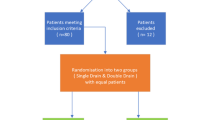Abstract
Breast abscess is a common challenge for the surgeon as well as the patient. There are various methods for the treatment of breast abscess. We have done a prospective study on the primary closure of breast abscess with a suction drain in situ after incision, drainage, and curettage. A total of 38 cases were enrolled in the study over a period of 34 months. We found the third decade as the most common age group. Lactation was the most common predisposing factor. Staphylococcus aureus was the most common organism in pus. Mean hospital stay was only 4.18 days. The mean healing time was 12.03 days (range 3–16 days). A comparative analysis of other similar studies was done. We concluded that for a large breast abscess, primary suturing after incision and drainage with curettage is a better procedure and should be used wherever possible as it reduces patient morbidity and discomfort.



Similar content being viewed by others
References
Khanna YK, Khanna A, Arora YK, Mathur G, Heda RR, Bhandari DR, Jhanji RN (1989) Primary closure of lactational breast abscess. J Indian Med Assoc 87:118–120
Ulitzsch D, Nyman MKG (2004) Breast abscess in lactating women: US-guided treatment. Radiology 232:904–909
Tewari M, Shukla HS (2006) An effective method of drainage of puerperal breast abscess by percutaneous placement of the suction drain. Indian J Surg 68:330–333
Elagili F, Abdullah N (2007) Aspiration of breast abscess under ultrasound guidance: outcome obtained and factors affecting success. Asian J Surg 30(1):40–44
Dubey V, Choudhary SK (2013) Incision and drainage versus incision and drainage with primary closure and use of closed suction drain in acute abscesses. WOUNDS 25(3):58–60
Cenap D, Inan A (2003) Breast abscesses in lactating women. World J Surg 27:130–133
Benson EA, Goodman MA (1970) Incision with primary suture in the treatment of acute puerperal breast abscess. Br J Surg 57:55–58
Knight ICS, Nolan B (1959) Breast abscess. Br Med J 1:1224–1226
Harish SK (1997) The catheter drainage of breast abscesses: is it going to be the future treatment of choice for puerperal breast abscess disease? Breast J 3:357–359
Page RE (1974) Treatment of axillary abscesses by incision and primary suture under antibiotic cover. Br J Surg 61:493–494
Nagpal SK, Sekhon GS (1979) Quat Journal of Surgical Science:59
Singer AJ, Thode HC Jr, Chale S, Taira BR, Lee C (2011) Primary closure of cutaneous abscesses: a systematic review. Am J Emerg Med 29:361–366
Ezeome ER, Adebamowo CA (2008 Sep) Closed suction drainage versus closed simple drainage in the management of modified radical mastectomy wounds. S Afr Med J 98(9):712–715
Gherardini G, Zaccheddu R, Milner SM (2006) Breast augmentation with silicone implants: the role of surgical drainage—report on 502 consecutive patients. Euro J Plast Surg 29:9–12
Bhagat KP (1979) Maharashtra medical journal 26(363)
Lawlor-Smith C Treating mastitis [letter; comment(1994) Treating mastitis. Aust Fam Physician 23(5):978–979
Matheson I, Aursnes I, Horgen M, Aabø Ø, Melby K (1988) Bacteriological findings and clinical symptoms in relation to clinical outcome in puerperal mastitis. Acta Obstet Gynecol Scand 67(8):723–726
Lawrence RA (1999) Breastfeeding - a guide for the medical profession, 5th edn. CV Mosby, St. Louis, pp 273–283
Fulton B, Moore LL (1992) Anti-infectives in breast milk. Part I: Penicillins and cephalosporins. J Hum Lact 8(3):157–158
Rench MA, Baker CJ (1989) Group B streptococcal breast abscess in a mother and mastitis in her infant. Obstet Gynecol 73(5 Pt 2):875–877
Schreiner RL, Coates T, Shackelford PG (1977) Possible breast milk transmission of group B streptococcal infection [letter]. J Pediatr 91(1):159–159
Eryilmaz R, Sahin M, HakanTekelioglu M, Daldal E (2005) Management of lactational breast abscesses. Breast 14:375–379 [Pubmed]
Author information
Authors and Affiliations
Corresponding author
Ethics declarations
Conflict of Interest
The authors declare that they have no conflict of interest.
Additional information
Publisher’s Note
Springer Nature remains neutral with regard to jurisdictional claims in published maps and institutional affiliations.
Rights and permissions
About this article
Cite this article
Surana, K., Sagrule, D. & Lanjewar, S. Primary Closure with Suction Drain of Acute Breast Abscess After Incision, Drainage, and Curettage. Indian J Surg 82, 129–133 (2020). https://doi.org/10.1007/s12262-019-01899-z
Received:
Accepted:
Published:
Issue Date:
DOI: https://doi.org/10.1007/s12262-019-01899-z




